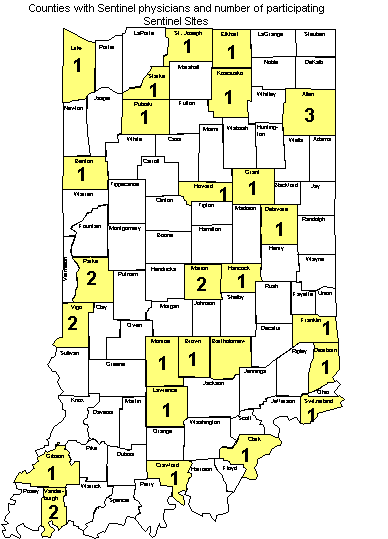Figure Inf1: Counties with Sentinel Physicians and Number of Participating Sites, Indiana, 2000

2000 Indiana Report of Infectious Diseases |
View ISDH's Quick Facts on Influenza A
View CDC's Flu in the United States page
Rates presented are per 100,000 population and are based on the U.S. 2000 Census.
Influenza surveillance during the 2000-2001 influenza season was conducted in cooperation with the U.S. Centers for Disease Control and Prevention (CDC). In Indiana, 34 physicians, nurse-managed clinics, emergency rooms, immediate care facilities, and university student health centers volunteered to be sentinel physicians/sites. Figure Inf1 shows the sentinel reporting locations and number of participating sites.
Surveillance for the 2000-2001 influenza season began the week ending Saturday, October 9, 2001, and continued weekly through April 30, 2001, tracking the numbers of patients presenting with "influenza-like-illness" (ILI). ILI is defined for the purpose of surveillance by the CDC as, " Fever (> 100 F[37.80 C] oral or equivalent) and cough or sore throat (in absence of a known cause)." In addition to tracking the number of patients with ILI, participants reported the total number of patients, broken down by specified age groups. Sentinel sites reported weekly, submitting the reports to the repository at the CDC via the internet, telephone, or facsimile. Additionally, participants collected nasopharyngeal swabs from patients with ILI whose onset of classic clinical signs had begun within 72 hours of the appointment. The swabs were sent to the Indiana State Department of Health (ISDH) Laboratories. The ISDH Labs conducted viral isolation and identification of influenza by type and subtype. During the surveillance period, sentinel sites saw 149,041 patients, of which 1,086 sought care for ILI. Figure Inf2 shows the percent of patients seeking care for ILI during the 1997-1998 through 2000-2001 seasons..
The index case occurred during the week ending November 25, 2000. The specimen was typed H1N1 and was obtained from a 20-year-old female from Vanderburgh County. The percentage of patients seen with ILI did not peak until the week ending January 27, 2001. Figure Inf3 presents the results of nasopharyngeal culturing of ILI patients. Unlike the previous season (1999-2000), where influenza A (H3N2) occurred throughout the season, the 2000-2001 season had influenza A (H1N1) and influenza B occurring simultaneously. Indiana did not have any confirmed influenza A (H3N2) during the entire influenza season. Typed influenza isolates were the same as those present in the 2000-2001 trivalent influenza vaccine. The components in the trivalent influenza vaccine were: A/Panama/2007/99-like, A/New Caledonia/20 /99-like, and B/Yamanashi.
Influenza A and B infections were widely distributed throughout Indiana, but the 2000-2001 season was considered to be mild. Of the 183 influenza cultures from Indiana that were typed by the ISDH Labs and the World Health Organization/National Respiratory and Enteric Virus Surveillance System Collaborating Laboratories, 122(68%) were Influenza A (H1N1), 0 (0%) were influenza A (H3N2), and 58 (32%) were influenza B. No influenza C infection was identified during the 2000-2001 season.
The age distribution of the patients seeking treatment of ILI correlated with the age distribution of previous years, with the exception of the 1999-2000 season. During the 1999-2000 season, the proportion of patients ages 5-24 was less than 50%. Figure Inf4 demonstrates the age distribution for the 2000-2001 influenza season.
Back to Top of Article
Back to Table of Contents
|
Figure Inf1: Counties with Sentinel Physicians and Number of Participating Sites, Indiana, 2000 |
|
|
Back to Reference in Text
Back to Top of Article
|
Figure Inf2: Percent of Patients Seeking Care for Influenza-Like-Illness, Indiana, 1997-2001 |
|
|
Back to Reference in Text
Back to Top of Article
|
Figure Inf3: Results of Nasopharyngeal Cultures by Week of Illness Onset, Indiana, 2000-2001 |
|
|
Back to Reference in Text
Back to Top of Article
|
Figure Inf4: Influenza Like Illness by Age Groups, Indiana, 1997-2001 |
|
|
Back to Reference in Text
Back to Top of Article
Back to Table of Contents
[an error occurred while processing this directive]